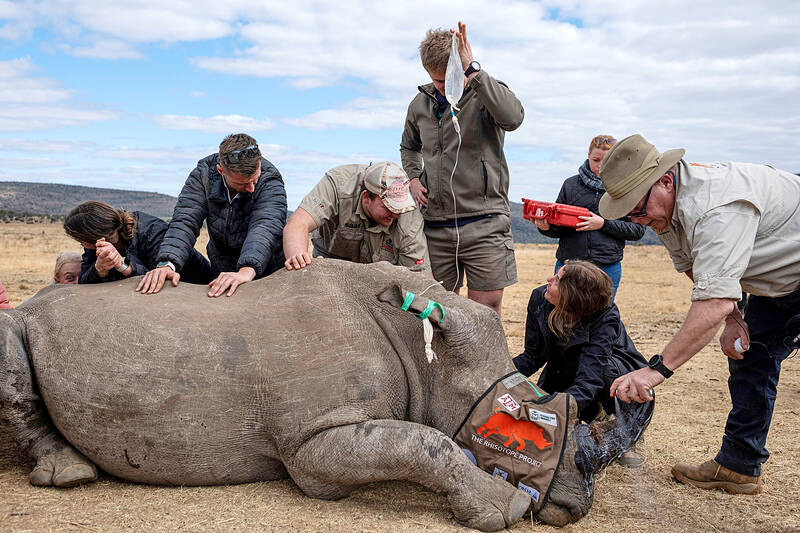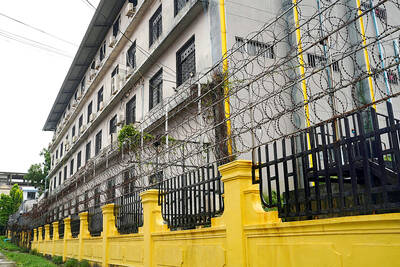South African scientists on Tuesday injected radioactive material into live rhino horns to make them easier to detect at border posts in a pioneering project aimed at curbing poaching.
The country is home to a large majority of the world’s rhinos, and as such, is a hotspot for poaching driven by demand from Asia, where horns are used in traditional medicine for their supposed therapeutic effect.
At the Rhino Orphanage in the Waterberg area of Limpopo province a few of the thick-skinned herbivores grazed in the low savannah.

Photo: AFP
James Larkin, director of the University of the Witwatersrand’s Radiation and Health Physics Unit who spearheaded the initiative, said that he had put “two tiny little radioactive chips in the horn” as he administered the radioisotopes on one of the large animals’ horns.
The radioactive material would “render the horn useless ... essentially poisonous for human consumption” said Nithaya Chetty, dean of the university’s Faculty of Science .
The dusty rhino, put to sleep and crouched on the ground, did not feel any pain, Larkin said.
The radioactive material’s dose was so low it would not affect the animal’s health or the environment in any way, he said.
In February, the South African Department of Environmental Affairs said that, despite government efforts to tackle the illicit trade, 499 of the giant mammals were killed last year, mostly in state-run parks.
This is an 11 percent increase from 2022.
Twenty live rhinos in total would be part of the pilot Rhisotope project, whereby they would be administered a dose “strong enough to set off detectors that are installed globally” at international border posts originally installed “to prevent nuclear terrorism,” Larkin said.
In addition to the thousands of radiation detectors installed at ports and airports, border agents often have handheld radiation detectors that can detect contraband, the scientists said.
Rhino horns are highly sought after on black markets, where the price by weight rivals that of gold and cocaine.
Arrie van Deventer, the orphanage’s founder, said that dehorning the rhino and poisoning the horns has failed to deter poachers.
“Maybe this is the thing that will stop poaching,” Van Deventer said. “This is the best idea I’ve ever heard.”
More than a dozen team members performed the delicate process on another rhino. Larkin meticulously drilled a small hole into the horn, hammered in the radioisotope, then finished off by spraying 11,000 microdots all over the horn.
The last phase of the project would be the animal’s aftercare following “proper scientific protocol and ethical protocol,” project chief operating officer Jessica Babich said.
The team would then take follow-up blood samples to ensure the rhinos are effectively protected.
The material would last five years on the horn, which is cheaper than dehorning every 18 months, Larkin said.
About 15,000 rhinos live in South Africa, the International Rhino Foundation has estimated.

Drug lord Jose Adolfo Macias Villamar, alias “Fito,” was Ecuador’s most-wanted fugitive before his arrest on Wednesday, more than a year after he escaped prison from where he commanded the country’s leading criminal gang. The former taxi driver turned crime boss became the prime target of law enforcement early last year after escaping from a prison in the southwestern port of Guayaquil. Ecuadoran President Daniel Noboa’s government released “wanted” posters with images of his face and offered US$1 million for information leading to his capture. In a country plagued by crime, members of Fito’s gang, Los Choneros, have responded with violence, using car

The team behind the long-awaited Vera Rubin Observatory in Chile yesterday published their first images, revealing breathtaking views of star-forming regions as well as distant galaxies. More than two decades in the making, the giant US-funded telescope sits perched at the summit of Cerro Pachon in central Chile, where dark skies and dry air provide ideal conditions for observing the cosmos. One of the debut images is a composite of 678 exposures taken over just seven hours, capturing the Trifid Nebula and the Lagoon Nebula — both several thousand light-years from Earth — glowing in vivid pinks against orange-red backdrops. The new image

CYBERCRIME, TRAFFICKING: A ‘pattern of state failures’ allowed the billion-dollar industry to flourish, including failures to investigate human rights abuses, it said Human rights group Amnesty International yesterday accused Cambodia’s government of “deliberately ignoring” abuses by cybercrime gangs that have trafficked people from across the world, including children, into slavery at brutal scam compounds. The London-based group said in a report that it had identified 53 scam centers and dozens more suspected sites across the country, including in the Southeast Asian nation’s capital, Phnom Penh. The prison-like compounds were ringed by high fences with razor wire, guarded by armed men and staffed by trafficking victims forced to defraud people across the globe, with those inside subjected to punishments including shocks from electric batons, confinement

Canada and the EU on Monday signed a defense and security pact as the transatlantic partners seek to better confront Russia, with worries over Washington’s reliability under US President Donald Trump. The deal was announced after a summit in Brussels between Canadian Prime Minister Mark Carney and European Commission President Ursula von der Leyen and European Council President Antonio Costa. “While NATO remains the cornerstone of our collective defense, this partnership will allow us to strengthen our preparedness ... to invest more and to invest smarter,” Costa told a news conference. “It opens new opportunities for companies on both sides of the